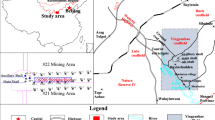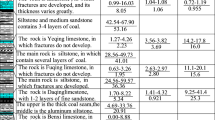Abstract
To deal with a water inrush issue that occurs in deep mines in China with more than one aquifer below the floor, the “down three zone” analysis method was modified to establish a conceptual model to evaluate the risk and mechanism of a water inrush. The model comprehensively considers the mechanical action, hydraulic connection, head loss of multiple aquifers, and an analysis of the complexity of water inrush in a multi-aquifer system to define water inrush conditions and criteria of different water inrush modes. There are four types of water inrush modes in a deep multi-aquifer system: single aquifer water inrush, multi-aquifer linkage water inrush, single aquifer lagging water inrush, and linked multi-aquifer lagging water inrush. Preventive and control measures for each of these are provided, based on: preventing linkage, eliminating hysteresis, preventing an inrush from a single aquifer, and preventing inrushes step by step.
Zusammenfassung
Um das Risiko und die Mechanismen von Wassereinbrüchen in tiefen chinesischen Bergwerken mit mehr als einem Aquifer im Liegenden zu bewerten, wurde der übliche „down three zone“-Ansatz durch die Entwicklung eines konzeptionellen Modells modifiziert. Das Modell berücksichtigt umfassend die mechanischen Vorgänge, die hydraulische Verbindung, die Druckverluste der Aquifere und eine Analyse der Komplexität des Wassereinbruchs in einem Multi-Aquifer-System, um die Bedingungen eines Wassereinbruchs und die Kriterien für unterschiedliche Wassereinbruchtypen zu bestimmen. In tiefen Multi-Aqufer-Systemen gibt es vier Wassereinbruchtypen: Einzel-Aquifer-Wassereinbrüche, verknüpfte Multi-Aquifer-Wassereinbrüche, verzögerte Einzel-Aquifer-Wassereinbrüche und verknüpfte verzögerte Multi-Aquifer-Wassereinbrüche. Für alle Typen werden präventive und Kontrollierende Maßnahmen vorgeschlagen. Sie basieren auf der Verhinderung von Verknüpfung, der Beseitigung von Hysterese, der Verhinderung des Wassereinbruchs aus einem einzelnen Aquifer und der Verhinderung eines Wassereinbruchs Schritt für Schritt.
Resumen
Para lidiar con un problema de irrupción de agua que ocurre en minas profundas en China con más de un acuífero debajo del piso, se modificó el método de análisis de “tres zonas abajo” para establecer un modelo conceptual para evaluar el riesgo y el mecanismo de irrupción de agua. El modelo considera de manera integral la acción mecánica, la conexión hidráulica, la pérdida de carga de múltiples acuíferos y un análisis de la complejidad de la irrupción de agua en un sistema de múltiples acuíferos para definir las condiciones y los criterios de los diferentes modos de irrupción de agua. Hay cuatro tipos de irrupción de agua en un sistema de múltiples acuíferos: desde un solo acuífero, desde varios acuíferos, retraso en la irrupción de agua desde un solo acuífero y retraso en la irrupción de agua desde varios acuíferos. Se proporcionan medidas preventivas y de control para cada uno de estos casos, basadas en la prevención del enlace, la eliminación de la histéresis, la prevención de la irrupción desde un solo acuífero y la prevención de irrupciones paso a paso.
抽象
为解决大采深矿井煤层底板下伏多含水层突水问题,对“下三带”进行了修正,建立概念模型,以评价突水风险。该模型综合考虑了多含水层的力学作用、水力联系和多含水层水头损失;分析了多含水层系统突水的复杂性,以确定不同突水模式的突水条件和标准。深部多含水层系统的突水模式有四种:单含水层突水、多含水层联合突水、单含水层滞后突水和多含水层滞后突水。基于防止联合突水、消除滞后突水、预防单含水层突水和预防逐步突水,提出了每种突水模式的预防和控制措施。



Similar content being viewed by others
References
Chen S, Yin D, Cao F, Liu Y, Ren K (2016) An overview of integrated surface subsidence-reducing technology in mining areas of China. Nat Hazards 81:1129–1145
Dong D, Sun W, Xi S (2012) Water-inrush assessment using a GIS-based Bayesian network for the 12-2 coal seam of the Kailuan Donghuantuo coal mine in China. Mine Water Environ 31:138–146
Du B (2012) Fathering practice of hidden water inrush subsided column in Jiulong Coalmine, Fengfeng mining area. China Coal Geol 24(3):31–35 (Chinese)
Guo W, Zhao J, Yin L, Kong D (2017) Simulating research on pressure distribution of floor pore water based on fluid–solid coupling. Arab J Geosci 10(1):1–14
Huang Z, Jiang Z, Zhu S, Qian Z, Cao D (2014) Characterizing the hydraulic conductivity of rock formations between deep coal and aquifers using injection tests. Int J Rock Mech Min 71:12–18
Jiang Y, Lu Y, Zhao Y, Zhang D (2011) Similar simulation test for breakage law of working face floor in coal mining above aquifer. J Rock Mech Geotech Eng 30(8):1571–1578 (Chinese)
Li B (1999) “Down three zone” for predicting water invasion from coal bed floor aquifer theory, development and application. J Shandong Univ Sci Technol (Nat Sci) 18(4):11–18 (Chinese)
Liang D, Jiang Z, Zhu S, Sun Q, Qian Z (2016) Experimental research on water inrush in tunnel construction. Nat Hazards 81(1):467–480
Lu H, Yao D, Shen D, Cao J (2015) Fracture mechanics solution of confined water progressive intrusion height of mining fracture floor. Min Sci Technol 25(1):99–106
Ma K, Yin L, Chen J, Chen M, Wang Z, Cui B (2018a) Theoretical analysis on failure of water-resisting key strata in the floor by local high confined water in deep mining. Rock Soil Mech 39(9):3213–3222 (Chinese)
Ma Q, Tan Y, Zhao Z, Xu Q, Wang J, Ding K (2018b) Roadside support schemes numerical simulation and field monitoring of gob-side entry retaining in soft floor and hard roof. Arab J Geosci. https://doi.org/10.1007/s12517-018-3904-9
Morsali M, Nakhaei M, Rezaei M, Hassanpour J, Nassery H (2017) A new approach to water head estimation based on water inflow into the tunnel (case study: Karaj water conveyance tunnel). Q J Eng Geol Hydrog 50(2):126–132
Qiu M, Shi L, Teng C, Zhou Y (2017) Assessment of water inrush risk using the fuzzy delphi analytic hierarchy process and Grey relational analysis in the Liangzhuang Coal Mine, China. Mine Water Environ 36(1):39–50
Shi L, Singh R (2001) Study of mine water inrush from floor strata through faults. Mine Water Environ 20(3):140–147
Sun W, Xue Y (2018) An improved fuzzy comprehensive evaluation system and application for risk assessment of floor water inrush in deep mining. Geotech Geol Eng. https://doi.org/10.1007/s10706-018-0673-x
Sun J, Wang L, Hou H (2013) Research on water-isolating capacity of the compound water-resisting key strata in coal seam floor. J China Univ Min Technol 42(4):560–566 (Chinese)
Sun J, Hu Y, Zhao G (2017a) Relationship between water inrush from coal seam floors and main roof weighting. Min Sci Technol 27(5):873–881
Sun W, Zhang S, Guo W, Liu W (2017b) Physical simulation of high-pressure water inrush through the floor of a deep mine. Mine Water Environ 36(4):542–549
Wang X, Wang T, Wang Q, Liu X, Li R, Liu B (2017) Evaluation of floor water inrush based on fractal theory and an improved analytic hierarchy process. Mine Water Environ 36(1):87–95
Wu Q, Xu H, Pang W (2008) GIS and ANN coupling model: an innovative approach to evaluate vulnerability of karst water inrush in coalmines of north China. Environ Geol 54(5):937–943
Wu Q, Zhou W, Wang J, Xie S (2009) Prediction of groundwater inrush into coal mines from aquifers underlying the coal seams in China: application of vulnerability index method to Zhangcun Coal Mine, China. Environ Geol 57(5):1187–1195
Wu Q, Zhang B, Zhao W, Liu S (2013) A new practical methodology of coal seam floor water burst evaluation: the comparison study among ANN, the weight of evidence and the logistic regression vulnerable index method based on GIS. J China Coal Soc 38(1):21–26 (Chinese)
Wu Q, Guo X, Shen J, Xu S, Liu S, Zeng Y (2017a) Risk Assessment of water inrush from aquifers underlying the Gushuyuan Coal Mine, China. Mine Water Environ 36(1):96–103
Wu Q, Liu Y, Wu H, Zeng Y (2017b) Assessment of floor water inrush with vulnerability index method: application in Malan Coal Mine of Shanxi Province, China. Q J Eng Geol Hydrog 50(2):169–178
Yin S, Hu W (2008) Rocks’ water-resistance ability and natural progressive intrusion height. Coal Geol Explor 36(1):34–36 (Chinese)
Yin D, Chen S, Liu X, Ma H (2018) Effect of joint angle in coal on failure mechanical behaviour of roof rock–coal combined body. Q J Eng Geol Hydrog 51(2):202–209
Zhao Y, Cao P, Wan W, Wang W, Zhang S, Zou S (2014a) Fluid–solid coupling analysis of water bursting catastrophe from concealed confined karst cave before roadway. J Cent South Univ 45(5):1598–1604
Zhao Y, Peng Q, Wan W, Wang W, Chen B (2014b) Fluid–solid coupling analysis of rock pillar stability for concealed karst cave ahead of a roadway based on catastrophic theory. Min Sci Technol 24(6):737–745
Zhao J, Yin L, Guo W (2018) Stress–seepage coupling of cataclastic rock masses based on digital image technologies. Rock Mech Rock Eng 51(8):2355–2372
Acknowledgements
The authors thank the anonymous reviewers for their constructive comments that helped to improve the quality of the paper. This study was supported by the National Natural Science Foundation of China (51604167), Postdoctoral Science Special Foundation of China (2015T80731), Postdoctoral Science Foundation Funding of China (2016M601171), and the Shandong Key Research and Development Project (2018GSF117018).
Author information
Authors and Affiliations
Corresponding author
Rights and permissions
About this article
Cite this article
Yin, L., Ma, K., Chen, J. et al. Mechanical Model on Water Inrush Assessment Related to Deep Mining Above Multiple Aquifers. Mine Water Environ 38, 827–836 (2019). https://doi.org/10.1007/s10230-019-00623-3
Received:
Accepted:
Published:
Issue Date:
DOI: https://doi.org/10.1007/s10230-019-00623-3




